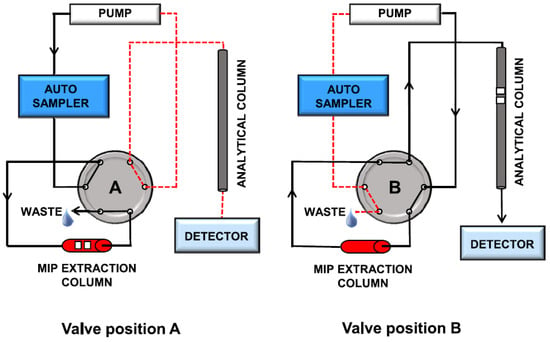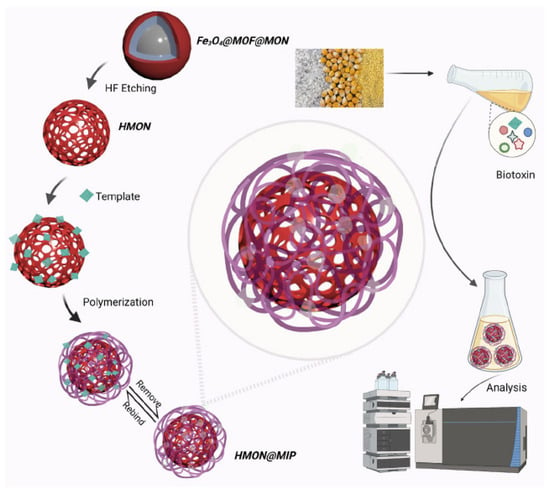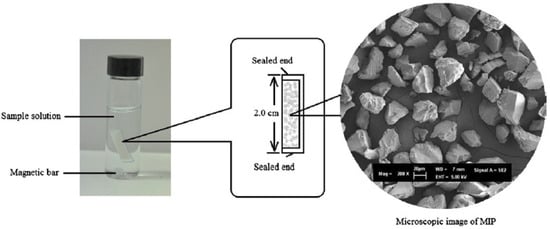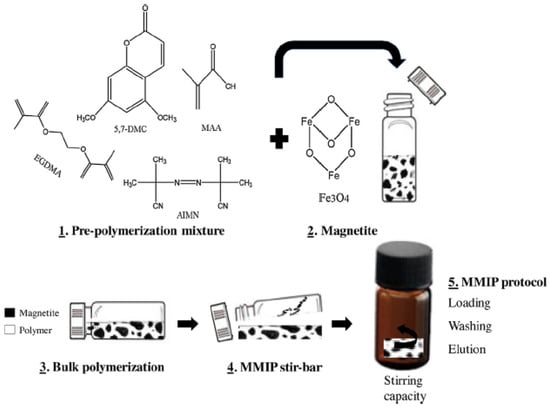1. Introduction
Mycotoxins are secondary metabolites produced by many fungal species. These natural toxicants are of concern in terms of food contamination and have long been known to be a significant source of food-borne illness posing severe risks to human health, not only after a single massive exposure, but, more often, after continuous exposure to low doses, and that such exposure can be related to several chronic diseases, including some types of cancer and serious hormonal dysfunctions
[1][2][3][1,2,3].
For mycotoxins, analytical methods characterized by a high sensitivity and selectivity, rapidity of execution, low cost, and suitability for mass screening are required worldwide
[4][5][4,5]. Commercially available rapid mass screening assays based on the use of immunoanalytical techniques are widely diffused
[6][7][6,7], but very frequently, a mycotoxin-contaminated sample must be confirmed by a separative analytical technique coupled with a mass spectrometry detector
[8][9][8,9]. These instrumental techniques are sufficiently sensitive for the detection and quantification of mycotoxin contamination, but direct application on real samples is difficult and a quantitative analysis can be performed only after extensive clean-up and preconcentration steps
[10]. Moreover, concerning current sample pre-treatment methods, they are based mostly on solid-phase extraction (SPE) techniques that are fast and cheap but not selective, while methods based on immunoaffinity extraction are very selective but expensive. Thus, economical, rapid, and target-focused extraction and purification approaches based on innovative solid-phase supports are required
[11][12][13][11,12,13].
Molecularly imprinted polymers are synthetic materials whose main feature is the presence of artificial binding sites which selectively recognize a target molecule
[14][15][16][14,15,16]. These materials are obtained via polymerization around a template molecule of one or more functional monomers selected according to their capacity to interact with the functional groups of the template. The presence of a cross-linking agent in the pre-polymerization mixture assures the formation of a stable three-dimensional network polymer containing binding sites with shape, size, and functional groups complementary to the template molecule. Once the template is removed, the artificial binding sites show the same properties of antibodies, i.e., similar thermodynamic and kinetic behavior, reversible binding, marked selectivity, and a high affinity constant.
Molecularly imprinted polymers represent good candidates for circumventing the aforementioned defects
[17]. In fact, in recent years, there has been a progressive increase in the literature concerning the development and use of MIPs with molecular recognition properties towards mycotoxins
Depending on the analytical task, the advantages offered by MIPs can combine the selective separation and preconcentration of the target mycotoxin from the bulk matrix. They have been applied mainly in food matrices using different polymerization techniques, supporting substrates, selectivity, and analytical applicability. As described in detail in the following sections, MIPs have been used to develop several extraction methods, including off-line and on-line SPE (Solid-Phase Extraction), MSPE (Magnetic Solid-Phase Extraction), and SBSE (Stir Bar Sorptive Extraction).
2. Solid-Phase Extraction with Commercial MIPs
At present, despite extensive matrix cleanup and target analyte preconcentration before analysis frequently being necessary, non-selective SPE sorbents (e.g., reverse-phase and ion-exchange, etc.) are still largely used in mycotoxin analysis because they are more easily accessible at lower prices
[18]. In any case, commercial MIP cartridges for several mycotoxins are available on the market
[19][20][68,69], and, in this context, examples of selective MISPE (molecularly imprinted solid-phase extraction) are reported in the literature for fumonisins B1-B3 in wheat and maize
[21][70], ochratoxin A in ginger
[22][71], grape juice, red wine and beer
[23][24][72,73], roasted coffee
[24][73], chili
[24][73], and cocoa beans
[25][74], patulin in apple juice, puree, and jam
[26][75], and zearalenone in wheat and maize
[27][76], vegetal oils
[28][77] and beer
[29][78].
It must be considered that some key features of these commercial polymers, such as their composition, synthesis method, and the potential use of a mimic template, are information that is undisclosed by the manufacturers, but, as their physical appearance is that of a homogeneous powder, it is reasonable to assume that these polymers are produced through a scalable technique, probably emulsion or precipitation polymerization, and not through a bulk process. As for the nature of the template, obvious considerations for the cost of the production of the materials and the absence of any trace of target analytes in blank matrices suggest the use of mimic templates.
All reported cases show that HPLC methods preceded by a clean-up and pre-concentration step performed on MISPE cartridges present analytical performances comparable to, if not better than, those obtained with non-selective or immunoextraction supports. As significant examples, a study published in 2013 compared MISPE cartridges for ochratoxin A with other commercial solid-phase extraction media, such as immunoaffinity columns (IAC), Mycosep™ 229, Mycospin™, and Oasis
® HLB
[24][73]. A total of 120 samples (30 wines, 30 beers, 30 roasted coffees, and 30 chili) were analyzed, and analytical recovery, reproducibility, limit of detection, and limit of quantification were evaluated. All the supports demonstrated suitability for OTA analysis, meeting the requirements specified in the EU regulations, with a moderate prevalence of IAC for wine and beer with an analytical recovery of >90%, as well as Mycosep™ for wine and chili, but MISPE was the most appropriate for coffee. In a more recent study
[30][79], commercial MIPs for ochratoxin A and zearalenone mixed with a home-made citrinin-imprinted bulk material were used to prepare multi-target analyte MISPE cartridges. A comparison in terms of analytical recovery and cleanup efficiency with cartridges packed with several synthetic nano- and microfibers, graphene-doped composites, and restricted access materials showed that, in the extraction of mycotoxin from oat and rice milk MISPE, poly-caprolactone nanofibers and C
18-restricted access cartridges performed better than the other solid phases in terms of cleanup efficiency, linearity, accuracy, and repeatability, with quantitative analytical recoveries for MISPE and poly-caprolactone nanofibers.
3. Solid-Phase Extraction with Home-Made MIPs
Despite the progress made in the last twenty years in terms of synthetic approaches to MIPs with the aim of improving both their structural and morphological characteristics and bonding properties
[31][32][80,81], the older technique of bulk onto polymerization still seems to prevail for home-made MIPs towards mycotoxins, with some relevant exceptions concerning miniemulsion polymerization for aflatoxin B1
[33][82], precipitation polymerization for citrinin
[34][83], and surface grafting for aflatoxins
[35][36][37][38][39][53,54,58,84,85], ochratoxin A
[40][86], patulin
[41][87], and zearalenone
[42][43][44][88,89,90]. In almost all cases, polymers are prepared using mimic templates, with some notable exceptions in the cases of fumonisins
[45][91] and T-2 toxin
[46][92], for which, as previously underlined, no mimic templates are known in the literature.
The number of mycotoxins and the type of real matrices for which the development of extraction procedures based on home-made MIPs is reported in the literature is wider than that relating to commercially available MISPE cartridges, which demonstrates the continuing interest of the scientific community in this topic. Aflatoxins B1, B2, G1, and G2 have been extracted from soy sauce and vinegar
[35][53], wheat and corn
[36][38][39][54,84,85], peanuts
[33][36][37][39][47][54,58,82,85,93], rice
[36][38][39][54,84,85], soybeans
[36][38][54,84], medicinal herbs and spices
[48][59], barley, beer and peanut oil
[33][82], figs, hazelnuts, and red pepper
[49][94]. Alternariol and alternariol 9-monomethylether have been extracted from tomato
[50][51][36,37], tomato juice and sesame oil
[51][37], maize, sunflower, and olive oils
[52][95]. Citrinin has been extracted from rice
[34][53][34,83], maize
[34][54][35,83], and rye
[34][83]. Fumonisins have been extracted from bell pepper, corn flakes, and rice
[45][91]. Ochratoxin A has been extracted from soybeans
[40][86] and red wine
[52][55][95,96]. Patulin has been extracted mainly from apple juice
[41][56][57][58][59][39,41,42,87,97], but also from apple, hawthorn, red wine, and tomato
[52][95]. T-2 toxin has been extracted from barley, maize, and oat
[46][92]. Zearalenone has been extracted from barley and rye
[60][29], rice
[43][60][29,89], wheat
[42][43][60][29,88,89], corn
[43][44][61][30,89,90], oats
[42][88], maize, and sunflower and olive oils
[52][95].
As in the case of MISPE developed on commercial cartridges, all those developed on home-made materials present analytical performances comparable to those obtained with non-selective or immunoextraction supports. For example, a bulk polymer imprinted with the T-2 mycotoxin was used to develop MISPE methods for maize, barley, and oat before HPLS-MS analysis
[46][92]. A comparison with extraction protocols based on Oasis
® HLB or immunoaffinity chromatography (IAC) cartridges showed that, although the highest analytical recoveries were obtained with the Oasis
® HLB sorbent (74–104% vs. 60–73% for MISPE and 60–85% for IAC, respectively), MISPE and IAC were superior regarding selectivity, cross-reactivity, and the matrix effect. Limits of detection (LOD) and limits of quantification (LOQ) resulted in being lower for MISPE (LOD: 0.4–0.6 ng/kg and LOQ: 1.4–1.9 ng/g) in comparison with Oasis
® HLB (LOD: 0.9–3.5 ng/g and LOQ: 3.1–11.7 ng/g) and IAC (LOD: 0.3–2.3 ng/g and LOQ: 1.0–7.7 ng/g). Interestingly, no template bleeding was observed, making the use of a hypothetical mimic template unnecessary.
4. On-Line Solid-Phase Extraction
A drawback of off-line SPE is that it can be time-consuming, frequently requiring many steps before the HPLC analysis. On the contrary, on-line SPE (Scheme 1) offers several advantages, reducing the sample preparation time and thus increasing the sample throughput. Moreover, analytical precision and accuracy increase due to the absence of a sample evaporation step before injection in the analytical column. A higher sensitivity is also achieved in on-line SPE due to the analysis of the full extracted sample in contrast to off-line SPE, where only a fraction of the extract is injected into the analytical column
[62][98]. It is therefore no coincidence that this approach has been successfully used for the extraction of several mycotoxins before HPLC analysis.
Scheme 1. An on-line SPE system for mycotoxin extraction and determination. Valve in position A; mycotoxin clean-up and preconcentration. Valve in position B: mycotoxin separation on analytical HPLC column
[63][99].
Ochratoxin A is a target analyte towards which numerous examples of on-line SPE have been reported. In this case, the typology of the imprinted stationary phases appears to be quite varied and includes stainless steel frits grafted with a thin layer of electropolymerized polypyrrole
[64][65][66][100,101,102] and an imprinted monolith prepared in a bare fused-silica capillary
[67][103] or a HPLC microcolumn
[68][104], but also traditional HPLC pre-columns packed with an MIP prepared via bulk polymerization
[68][69][104,105]. In all these cases (except
[69][105], where ochratoxin A is directly quantified without any further separative step), as the extraction step is followed by separation on an HPLC analytical column, the critical step for a successful method consists of the use of a desorption eluent compatible with the analytical eluent used in the HPLC column. This step therefore involves methanol/triethylamine as the desorption element and methanol/ammonium buffer as the analytical eluent
[64][65][66][100,101,102], methanol/acetic acid as both the desorption and analytical eluent
[67][103], methanol/acetic acid as the desorption element, and acetonitrile/water/acetic acid as the analytical eluent
[68][69][70][104,105,106]. The on-line extraction of beer
[67][103], wheat extracts
[69][70][105,106], and red wine
[64][65][66][100,101,102] resulted in being selective for the target analyte and allowed for the quantification of the contamination levels in these matrices being well below the legal limits established by the health authorities. Aside from ochratoxin A, on-line SPE in a packed microcolumn has been reported for citrinin in red yeast rice extracts
[71][107] and patulin in apple juice
[72][73][108,109]. It must be noted that, in the latter paper, the authors compared off-line and on-line SPE methods on the same imprinted polymer of commercial origin, concluding that, although on-line SPE leads to significant time savings, fewer human errors, and requires no handling of toxic solvents, it showed a worse LOD (15 versus 6 ng/mL), worse analytical recovery values (68.3–123.5 versus 81.2–109.9%), and a worse efficiency throughout the entire clean-up process in comparison with the off-line SPE.
5. Dispersive Solid-Phase Microextraction
In dispersive solid-phase microextraction (DSPME), the solution containing the target analytes is not percolated through a cartridge containing the sorbent, as in the case for SPE, but it is the sorbent that is added into the sample solution and stirred for a specified time until the adsorption of the target analytes reaches its equilibrium. Then, the mixture is centrifuged or filtered to separate the sorbent, and the sample solution is discarded. A desorption solvent is finally added to the sorbent and a small volume of it is injected into the detection system for the determination of the target analytes
[73][109]. In comparison with the similar Solid-Phase Microextraction (SPME), DSPME presents several advantages due to the absence of the fiber supporting the solid phase, including drawbacks due to the necessity of covalently grafting the sorbent onto the fibers, the fiber mechanical fragility, and the need to have the appropriate desorption apparatus connected to the analytical instrument
[74][110].
Concerning mycotoxin analysis, Fan et al. used bulk polymerization in the presence of 7-ethoxycoumarin to set-up the DSPME of aflatoxin B1 in peanut samples with detection via post-extraction Surface-Enhanced Raman Spectroscopy (SERS) with an LOD of 0.1 ng/mL
[75][55]. Jayasinghe et al. used DSPME to extract aflatoxins B1, B2, G1, G2, and M1 from fish samples using a mimic-imprinted bulk material before an HPLC-MS/MS analysis
[76][111]. Despite a strong matrix effect requiring the application of a standard addition method for aflatoxins G1 and M1, the extraction method was found to be simple, rapid, and highly selective, with analytical recoveries in the range of 80–100% and a good LOD (B1: 0.11 ± 0.03 ng/mL, B2: 0.20 ± 0.06 ng/mL, G1: 0.12 ± 0.03 ng/mL, G2: 0.20 ± 0.06 ng/mL, and M1: 0.10 ± 0.03 ng/mL, respectively) and LOQ (B1: 0.37 ± 0.11 ng/mL, B2: 0.67 ± 0.20 ng/mL, G1: 0.40 ± 0.12 ng/mL, G2: 0.68 ± 0.20 ng/mL, and M1: 0.32 ± 0.06 ng/mL, respectively). The same approach has been very recently reported by Thati et al. for the HPLC analysis of four aflatoxins (B1, B2, G1, and G2) in a large variety of food samples such as cereal grains, dry nuts, spices, oil seeds, vegetables, mushrooms, pulses, milk, and bread
[77][112]. The extraction method proved to be compatible with a wide range of different matrices, highly selective, and reusable, with analytical recoveries in the range of 79.1–109.4% and a good LOD (B1: 0.193 ng/mL, B2: 0.087 ng/mL, G1: 0.208 ng/mL, and G2: 0.059 ng/mL, respectively) and LOQ (B1: 0.644 ng/mL, B2: 0.292 ng/mL, G1: 0.694 ng/mL, and G2: 0.197 ng/mL, respectively).
With the aim of increasing adsorption capacity, Yang et al. used a hollow-structured microporous organic network (HMON, Scheme 2) as a nanostructured scaffold to support and facilitate the imprinting of polymeric nanoparticles with mimic templates for aflatoxin B1 and sterigmatocystin
[78][113]. The HMON@MIPs resulted in being characterized by a significantly increased imprinted binding site density and binding affinity for the target compounds. They were used for the extraction of mycotoxins from rice, maize, and soybean samples in DMSPE mode, resulting in being selective with analytical recoveries in the range of 81.2–95.1% and a very low LOD (4.4 and 6.7 pg/mL) and LOQ (14.6 and 23 pg/mL) for aflatoxin B1 and sterigmatocystin, respectively.
Scheme 2. Schematic protocol of the integration of hollow-structured HMON@MIPs as adsorbents for DMSPE and highly sensitive determination of mycotoxins in food samples
[78][113].
Related to DSPME is the micro-solid-phase extraction method described by Lee et al. for the extraction of ochratoxin A from coffee and grape juice
[79][114]. The authors packed an MIP prepared in bulk within a sealed polypropylene porous membrane, and the envelope was put into a vial containing the sample to be extracted (Scheme 3). After the extraction step, the ochratoxin was desorbed and analyzed via HPLC with analytical recoveries ranging from 90.6% to 101.5% and an LOD (0.06, 0.02, and 0.02 ng/mL) and LOQ (0.19, 0.06, and 0.08 ng/mL) comparable with those obtained via MISPE. The same approach was described by Chmangui et al. for the extraction of aflatoxins B1 and B2 from seed-derived beverages (soya, rice, almond, coconut, oat, and tigernut)
[80][52]. Despite a marked matrix effect, aflatoxins were determined via HPLC-MS/MS with analytical recoveries in the range of 91–104% and limits of detection within the 0.085–0.207 ng/mL range.
Scheme 3. Schematic diagram and microscopic image of micro-solid phase extraction used by Lee et al. for ochratoxin A extraction and preconcentration
[79][114].
6. Magnetic Solid-Phase Extraction and Stir Bar Sorptive Extraction
MSPE is based on the dispersion of paramagnetic nano- or microparticles coated with a sorbent layer in a sample solution. Once the retention process of the target analytes is concluded, the paramagnetic particles are separated from the solution by the application of an external magnet and the supernatant is then discarded. Subsequently, the elution process is carried out through the addition of an appropriate solvent to ensure the analytes’ desorption
[81][82][115,116]. In addition to its operational simplicity, MSPE is efficient, economical, and does not need additional steps, such as centrifugation, precipitation, or filtration, thus avoiding the loss of analytes. Moreover, the ability of limited amounts of particles—typically tens of mg—to extract target analytes from large-volume samples allows for easily obtaining high preconcentration factors, greatly amplifying the analytical sensitivity of the methods.
In regard to the analysis of mycotoxins, if compared to off- and on-line SPE, the examples of MSPE reported in the literature are relatively more recent, no older than about ten years ago and concerning a smaller number of target analytes and real matrices. Aflatoxins B1, B2, and G2 have been extracted jointly from corn
[83][56], B1 and B2 from corn and peanut oil
[84][117], and B1 alone from barley and beer
[85][118] and bovine liver
[86][119]. Using deoxynivalenol as a template, fusarotoxins (fusarenon-X, deoxynivalenol, 3-acetyldeoxynivalenol, 15-acetyldeoxynivalenol, T-2 toxin, and HT-2 toxin) have been extracted from rice
[87][120]. Ochratoxins A, B, and C have been extracted from rice and wine
[88][121]. Patulin has been extracted from several fruit juices
[89][90][44,122]. Sterigmatocystin has been extracted from wheat
[91][123]. To conclude, zearalenone has been extracted from a wider variety of matrices: buckwheat
[92][32], corn
[93][94][95][124,125,126], corn oil
[96][127], flour
[93][124], maize
[92][97][32,128], millet
[95][126], rice
[91][92][93][32,123,124], and wheat
[92][94][98][32,125,129]. In all these cases, MSPE methods present analytical performances in terms of limits of detection and quantification, analytical recovery, and matrix clean-up comparable to, if not better than, those obtained with cartridge-based MISPE methods. As a relevant example, the MSPE for fusarotoxins reported by Pan et al.
[87][120] shows, for T2-toxin, a limit of detection of 5 pg/g and a limit of quantification of 20 pg/g with HPLC-MS/MS detection, while the off-line MISPE for the T2-toxin reported by De Smet et al.
[46][92] shows limits of detection and quantification higher than two orders of magnitude, 0.4–0.6 ng/g and 1.4–1.9 ng/g, respectively.
A variant of the MSPE is the SBSE, where, instead of paramagnetic nano- or microparticles, a solid magnetic stir bar grafted with a layer of sorbent material is used to extract the target analytes
[99][130]. In regard to mycotoxin analysis, an interesting example of SBSE concerns the development of magnetic stir bars composed of a monolithic MIP embedding paramagnetic Fe
3O
4 microparticles through a bulk polymerization process (Scheme 4). When imprinted with a mimic for aflatoxins
[100][50], the stir bar was able to extract aflatoxin M1 from milk powder for baby food with an analytical recovery of 60% (LOD: 1.0 ng/kg and LOQ: 0.3 ng/kg) and aflatoxins B1, B2, G1, and G2 in cereal-based baby foods with analytical recoveries of 43, 40, 44, and 39%, respectively (LOD: 0.9, 0.7, 1.0, and 1.7 ng/kg and LOQ: 3.0, 2.3, 3.5, and 5.8 ng/kg). Concerning patulin
[101][43], it was extracted from apple with recoveries of 60–70% (LOD: 10 ng/g and LOQ: 50 ng/g).
Scheme 4. Preparation and use of magnetic molecularly imprinted stir-bars [100]. Preparation and use of magnetic molecularly imprinted stir-bars [50].




